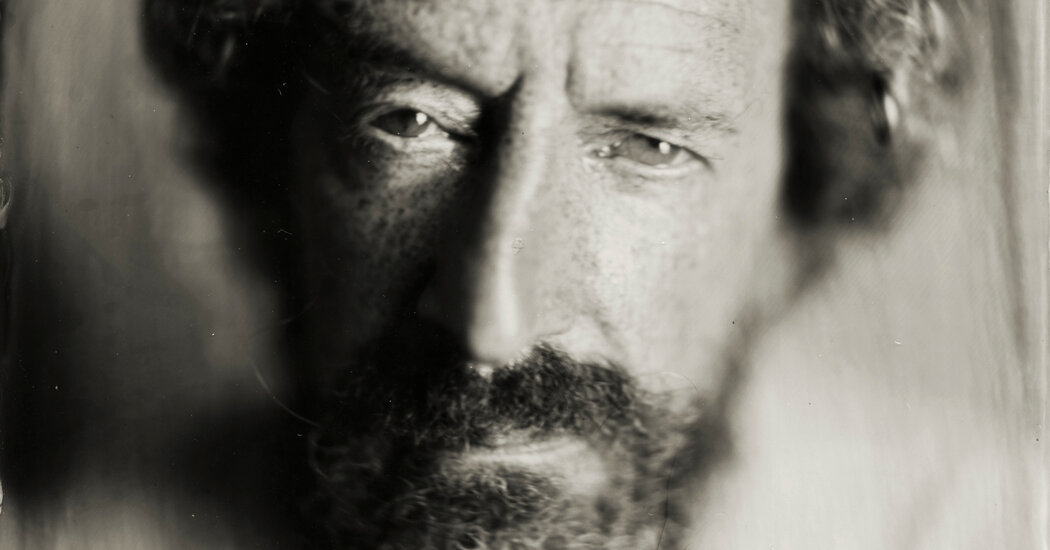Hal Hirshorn, an artist known for his ubiquity around New York City’s cultural scene, who nevertheless managed to exist outside its manic commercial hustle, using antique cameras and homemade paints to produce haunting photographs and landscape paintings, died on Feb. 4. He was 60.
His sister, Harriet Hirshorn, said the cause was coronary artery disease. He died at a friend’s apartment in Manhattan, where he had gone to celebrate the opening of a group show featuring his work, “Let There Be Light,” at the Church of the Heavenly Rest on the Upper East Side.
New York artists are often spoken of in monolithic terms, as if they are all racing to be the next Jeff Koons. Many are. For those who aren’t, Mr. Hirshorn served as an avatar and inspiration, a model for how to live a creative life seemingly unencumbered by monetary concerns.
While other artists of his generation rode the art-market boom of the last three decades, he remained aloof, rarely putting his work up for sale at galleries. His spare website features a few of his paintings and photographs, but no contact information or personal details.
His work was absolutely analog. Mr. Hirshorn made his own paints using traditional ingredients, and he scoured the Chelsea flea market for antique camera parts, the older and more obscure the better.
His landscapes drew on a color palette of dirty greens and autumnal browns. They were Turner-esque in their near abstraction, with swirls of misty clouds obscuring craggy cliffs and stormy seas.
His photographs likewise seemed to exist out of time. He made them by applying a solution of salt and silver to drawing paper, layering it with a negative and exposing it to light to capture an image — a technique developed in England in the mid-19th century that eventually fell out of favor because it required very long exposures that made it hard to keep an image in focus.
But that quality was what Mr. Hirshorn liked: The blurriness produced an ethereality in his photos, often of women, either nude or engaged in antiquated domestic work, like floor scrubbing. To add verisimilitude, he sometimes used makeup to dirty his models’ feet.
In other works, he created “memento mori,” using a 19th-century approach to photography in which the body of a recently deceased person is arranged in a lifelike pose. (Mr. Hirshorn, however, used live models.)
In 2011, he staged a “funeral” for Seabury Tredwell, a wealthy Manhattanite who died in 1865, taking pictures of the procession as it moved from the Merchant’s House Museum, where Mr. Tredwell and his family had lived, in the East Village, to Grace Church and finally the New York City Marble Cemetery.
“His sensibility was to reference and echo 19th-century painting and photography,” Geoffrey Berliner, a photographer and close friend of Mr. Hirshorn’s, said in an interview. “But to do it in personal, subjective and contemporary ways.”
Mr. Hirshorn’s personality matched his art.
For some reason, he had a LinkedIn page; unsurprisingly, it was sparse and enigmatic, describing him as an “artist at everything and nothing” — which he most certainly was.
He seemed to be everywhere. His friends and admirers called him Zelig-like, as they would often encounter him at museums and gallery openings, but also randomly walking down the sidewalk or through Central Park.
“If I didn’t know better, I’d have thought he was stalking me,” the painter Alix Bailey said in an interview. “But that was everyone’s experience with Hal.”
He was hard to miss, with his thin, pallid face, mop of curls and piercing eyes. His fingers were tobacco stained from decades of smoking. He had a habit of walking slowly and then suddenly breaking into a sprint for a few seconds before braking.
He spoke quietly, deliberately and with great erudition; he was polite, even a bit formal. He had an encyclopedic awareness of art history up to the latest trends, though he preferred the side channels of long-forgotten artists and movements.
“There was something almost Edwardian about him,” James Harney, a friend, said in an interview. “But he also had a playful quality.”
Harold Timothy Hirshorn was born on Jan. 12, 1965, in Philadelphia. His father, Bruce Hirshorn, was a Foreign Service officer, and as a result Hal had a peripatetic childhood, living in Brussels, London and Hong Kong, among other places, before winding up in Washington.
His mother, Anne Sue (Friedberg) Hirshorn, was an art historian who worked for the U.S. Information Agency. After his parents divorced when he was 9, Hal lived with her in Washington. He often cited her as a major influence on his work.
Along with his sister, Mr. Hirshorn is survived by his brothers, Barry and Dalton.
He attended Bennington College, where he studied art history and architecture, but left before graduating. He also studied in Venice through a fellowship with the Peggy Guggenheim Collection.
Mr. Hirshorn arrived in New York in 1989, just as an economic recession was bringing an end to the decade’s furious boom in art and real estate around Lower Manhattan.
He gravitated to the galleries and clubs in the East Village, where much of the 1980s boom had percolated, but discovered that its once-cheap housing was being uprooted by gentrification.
Instead he found a tiny, rent-controlled studio apartment off Washington Square Park, where he lived for the rest of his life, filling the space floor to ceiling with camera parts, books and artistic ephemera. It was cheap, but spartan: He had a hot plate and shared a bathroom with another renter.
“Much is made about fame and influence and stuff, and none of that matters compared to your inner dialogue of why you make art,” the artist Tom Sachs, who knew Mr. Hirshorn from college, said in an interview. “Hal’s art was like that. He had a very personal sort of inner dialogue about his art.”
Last year, Mr. Hirshorn and a friend from high school, Jeremy Hutchins, drove to Midland, Ga., for his latest project, at Pierce Chapel African Cemetery. During the 19th century, dozens of enslaved people were buried on the site, which a group of Black preservationists is trying to restore.
As he did with the Tredwell series, Mr. Hirshorn staged a funeral and shot it with his salt-print camera.
He did not have a chance to develop the negatives before he died, but Mr. Hutchins said he hopes to finish his friend’s work this year. There will also be an exhibit of Mr. Hirshorn’s work and extensive collection of antique cameras this month at the Ethan Cohen Gallery, in the Chelsea section of Manhattan.


